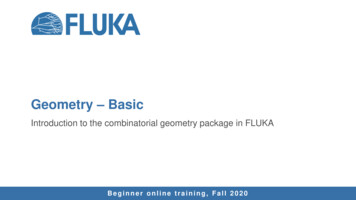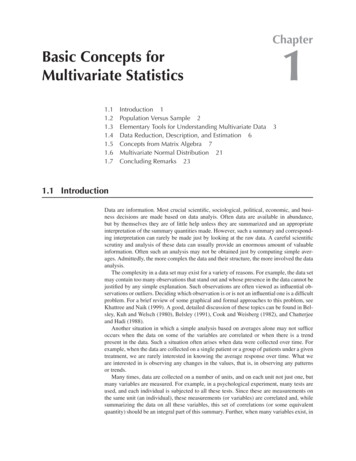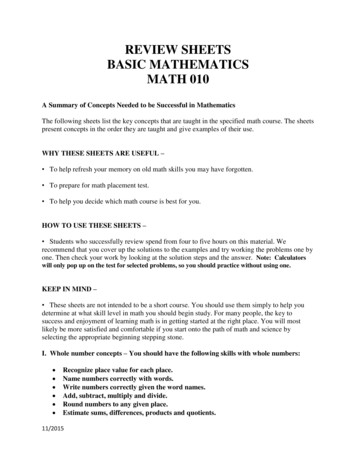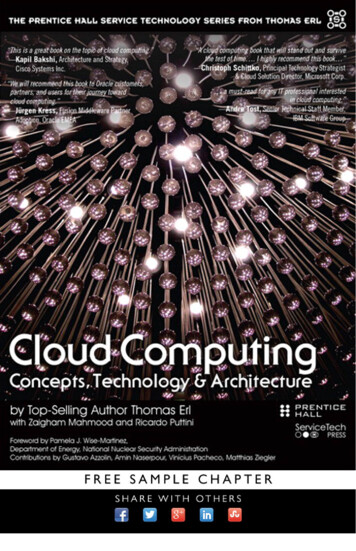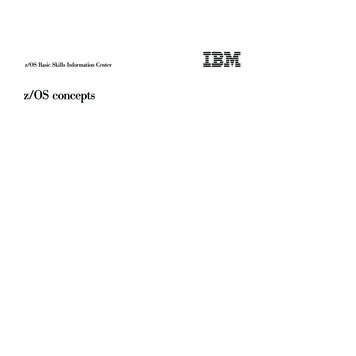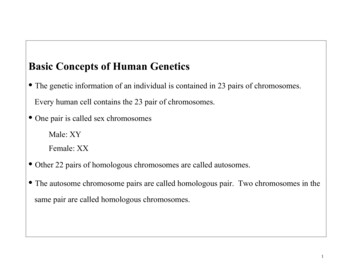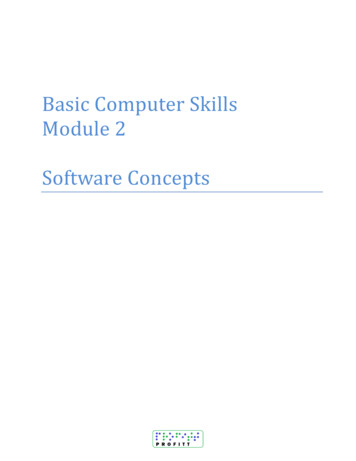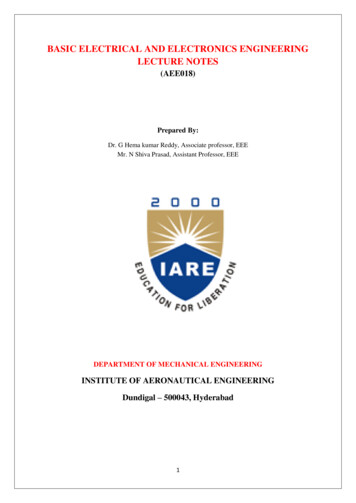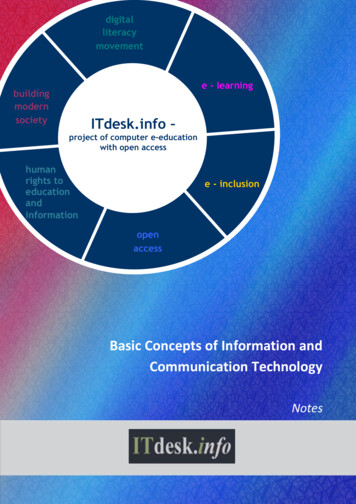
Transcription
digitalliteracymovemente - learningbuildingmodernsocietyITdesk.info –project of computer e-educationwith open accesshumanrights toeducationandinformatione - inclusionopenaccessBasic Concepts of Information andCommunication TechnologyNotes
Main title:ITdesk.info – project of computer e-education with open accessSubtitle:Basic Concepts of Information and Communication Technology , notesAuthor:Dario Ilija RendulićExpert review:Victor KuoProofreading:Ana DzajaCover:Publisher:Open Society for Idea Exchange (ODRAZI), ZagrebISBN:978-953-56758-7-7Place and year of publication:Zagreb, 2011Education and Teacher Training Agency in Croatia has approved the use of this publication as officialadditional teaching resource in all the primary schools in CroatiaClass: 602-09/14-01/0418Reg: 561-03-03/10-15-4Zagreb, April 2015.Copyright:Feel free to copy, print, and further distribute this publication entirely or partly, including tothe purpose of organized education, whether in public or private educational organizations,but exclusively for noncommercial purposes (i.e. free of charge to end users using thispublication) and with attribution of the source (source: www.ITdesk.info - project of computere-education with open access). Derivative works without prior approval of the copyrightholder (NGO Open Society for Idea Exchange) are not permitted.Permission may be granted through the following email address: info@ITdesk.info
ITdesk.info – project of computer e-education with open accessPrefaceModern society is characterized by sudden growth and development ofinformation technology (IT) resulting in large dependence of the society, ina wider sense, on the individual knowledge and competence of a person inthe IT area. Although this dependence grows on daily basis, the humanright to education and information is not extended to IT area. Problemsthat affect society as a whole emerge, creating gaps and distancing peoplefrom the main reason and motivation for advancement - from opportunity.Today, being a computer illiterate person means to be a person who isunable to participate in modern society, a person without opportunity andin spite of acknowledged necessity and benefits of inclusive computerliteracy by, for example, European Commission, UNESCO, OECD, there arestill groups of people with hindered access to basic computer education(persons with disabilities, persons with learning difficulties, migrantworkers, unemployed, persons that live in remote (rural) areas where ITeducation is not accessible).These notes, combined with other materials published on ITdesk.info,represent our effort and contribution to realization and promotion of thehuman right to education and information considering IT area. We hopethat this education will help you master basic computer skills and with thathope we wish you to learn as much as you can thus becoming an activemember of modern IT society.Sincerely yours,ITdesk.info teamITdesk.info is licensed under a Creative Commons AttributionNoncommercial-No Derivative Works 3.0 Croatia License.
ITdesk.info – project of computer e-education with open accessBasics of the information technologyInformation technology (IT) is a technology which uses computers to gather, process, store, protect,and transfer information. Today, it is common to use the term Information and communicationstechnology (ICT) because it is unimaginable to work on a computer which is not connected to thenetwork.The computer consists of: hardware – physical computer parts, palpable and visible software – set of commands that are "understandable" to the computer; instructions to itspalpable parts, giving orders what to doBasic principle of computers:Data enters the computer through one or more input devices. The computer then processes the dataand transmits the resulting data to output devices. Output devices can be human interfaces such as ascreen or another electronic device such as a storage device or computer network.The system unit consists of the following components: Motherboard - MBOo a computer "backbone" responsible for communication between components andtransmission of information Central Processing Unit - CPUo functions: command execution, data transmission, computer function controlo basic characteristics: speed (in Mega Hertz (MHz), Giga Hertz (GHz)) amount of memory (Cache in Bytes) Random Access Memory - RAMo a memory container for programs that are currently running and data that is beingprocessedo basic characteristics: speed (in MHz, GHz) capacity (in Bytes) data rate class (DDR SDRAM, SDR SDRAM) permanent memory:o Hard Disk Drive - HDD - device (memory) used for permanent data storage data is stored on magnetic platters; electromagnetic heads are used for readingand recording data with the exception of the newest disk types called Solid StateDrive (SSD) basic characteristics: disk platters rotation speed (in RPM) capacity (in GB) connection interface (IDE, SATA)o Floppy Disk Drive - FDDo optical disks - CD, DVDITdesk.info is licensed under a Creative Commons AttributionNoncommercial-No Derivative Works 3.0 Croatia License.1/11
ITdesk.info – project of computer e-education with open access graphics processing units (GPU)o function: processing and displaying image on the monitoro it consists of a graphics processor and its own working RAM memoryo basic characteristics: type of graphics processing units (ATI Radeon, Nvidia GeForce, or other) RAM size connection interface/slot type ports:o Parallel Porto Serial Porto Universal Serial Bus (USB)Input and output devices Input devices:o keyboardo scannero touchpado mouseo trackballo joysticko microphoneo styluso camera (web, digital) Output devices:o monitoro projectoro printero plottero speakerso earphonesDevice that is both input and output: touchscreen.Common devices and media for storing and transferring data: hard disk network disk drive USB flash drive online storage device diskette and ZIP diskette CD and DVD discs memory cards internal hard disk external hard diskSoftware - a computer program which, as opposed to hardware, is an intangible part of thecomputer, written to perform a single or multiple tasks on computer using the built-in hardware.Software types: operating systems (OS) - the basic program on your computer that is automatically loadedwhen computer is started up:o Linux (Debian, Ubuntu, Fedora, Knoppix.)o Microsoft Windows (XP, Vista, 7.)o Mac OS X (Cheetah, Panther, Snow Leopard.)ITdesk.info is licensed under a Creative Commons AttributionNoncommercial-No Derivative Works 3.0 Croatia License.2/11
ITdesk.info – project of computer e-education with open access application software – some types of software that can be used on an installed operatingsystem:o office programs - OpenOffice.org, LibreOffice, Microsoft Officeo antivirus program – Avira, Sophos, Kaspersky etc.o Web browser: Mozilla Firefox, Microsoft Internet Explorer, Opera, SafariE -accessibility options: voice recognition software, screen reader, magnifying tool, on-screen keyboard.Computer types: Mainframe Computero large, powerful and expensive computers,o often used within large systems and organizations,o can be used by more then one user simultaneously. Personal Computer – PCo first PC was made by IBM in 1981,o it was originally made for executing a single task by a single user at the time.o today: a single person can execute many tasks simultaneously (multitasking). Apple Macintosh (Mac)o personal computer made by Apple company, Laptop computer (notebook)o relatively small computers, easily carried around,o consists of LCD display and a small keyboard,o do not fall behind PCs by their functions Personal Digital Assistant - PDA (Palm)o small computers that can fit into a pocket or user's palm,o meant for performing basic personal/business functions: managing personal or business tasks and assignments, maintaining the address book, accessing and browsing the Internet, sending/receiving e-mails, etc.o PDAs have now been replaced by modern smart phones that combine the features of aPDA with a mobile phone and camera. Network connected computero every computer (PC, notebook, PDA) connected to the network is considered a networkcomputer; can be connected either through network cable or through a phone line (atleast to one more computer)ITdesk.info is licensed under a Creative Commons AttributionNoncommercial-No Derivative Works 3.0 Croatia License.3/11
ITdesk.info – project of computer e-education with open accessBeside notebooks and palms, there are other portable digital devices: mobile phone smartphone – mobile phone with advanced functions such as e-mail, Internet browser, ebook reader multimedia player: iPod, iRiver, ZuneNetworks: LAN (Local Area Network) - a small network that physically connects nearby computers(computers within the firm, organization, or a household) WAN (Wide Area Network) - a larger network that covers a city or a region, Internet – a world network of connected computers, connected through WAN and LAN Intranet - a smaller network, closed version of internet to which only certain (authorized)people are granted access (members of an organization) Extranet – an intranet version, to which only certain people are granted access (notexclusively members of an organization, but also outsourced experts for performing commontasks), World Wide Web (WWW) - one of the services that can be used on Internet which enables usto view and search contents in a form of web-pages other services on Internet that can be used:o Instant messaging (IM) - Google Talk, Skype, Windows Live Messenger, Yahoo!Messengero Voice over Internet Protocol (VoIP) - protocol used for voice transfer over IP network; itbasically enables us to use internet in order to make phone-callso Really Simple Syndication (RSS) – used for dissemination of information or articles etc.published on web page using RSS channel (RSS news usually consists of title, fewsentences and link to a web page where users can read the whole article). Users have tosubscribe to RSS channel in order to receive news in their RSS reader. This eliminates aneed for visiting a web page in order to find out latest newso web log blogo podcast - digital file that contains audio or video recordNetwork communication: PSTN (Public Switched Telephone Network) – a technical expression for public telephonesystem ISDN (Integrated Services Digital Network) ADSL (Asymmetric Digital Subscriber Line) – most common communication standard in theconsumer marketInternet data transfer: download - data storing from internet onto personal computer upload - data storing from personal computer to internet server data rate units:o bit per second (bps), kilobit per second (kbps), and megabit per second (mbps). Internet access:o dial-up – use of phone line in order to connect to the internet. The bill for the internetusage is directly proportional to the time spent on the Internet and/or the amount ofdata transferred.o broadband – the bill is formed according to speed of data transfer. Additionally, in areaswhere informational infrastructure for broadband is not developed enough (or for otherreason), amount of data transfer is also charged. Unlike dial-up, time spent on theITdesk.info is licensed under a Creative Commons AttributionNoncommercial-No Derivative Works 3.0 Croatia License.4/11
ITdesk.info – project of computer e-education with open accessointernet is not charged and as a consequence there is a greater risk from hackerintrusion in computers or networks that are connected to internet 24/7Internet can also be accessed through phone, mobile, and cable line, as well as throughwireless access or via satellite connection.Virtual (online) communities social networking websites: Facebook, Bebo, Twitter, MySpace, LinkedIn, Nexopia, Hi5,Tagged, XING, Orkut, etc. Internet forums – Forum.hr, Download.hr, etc. chat rooms, e.g. Chat Rooms multiplayer games: Silkroad Online, Knight Online, Anarchy Online, Guild Wars, World ofWarcraftWays to publish and share contents on the internet: blog, podcast, photos, video and audio contents.Advices on how to protect oneself while using virtual communities: protect privacy of your profile, limit publishing and use of your personal data, be aware that published information can be publicly accessible, be cautious while communicating with strangers.Computer in the workplace: tasks more suited to a computer than a human:o repetitive tasks,o easy automated tasks ,o mathematical operations,o tasks that require high precision and speed. tasks more suited to a human than a computer:o logical reasoning and shape interpretation,o consulting and social interaction,o new product presentation,o developing business plan and strategies.Information and Communication Technology (ITC) exists in every aspect of modern society. Somewell known applications include:o applications for corporations (airlines, insurance companies, internet banking)o applications for state organizations (electronic voting, tax refund)o applications for healthcare (data about patients, diagnostic tools and instruments,special surgical equipment)o applications for education (computer based training - CBT, distance learning, elearning): adaptive learning time, flexible learning location, multimedia learningexperience, reduced costs.Telecommuting (telework) Advantages:o increasing the employment of vulnerable groups: parents with small children, peoplewith mobility problems and people living in the remote areas,ITdesk.info is licensed under a Creative Commons AttributionNoncommercial-No Derivative Works 3.0 Croatia License.5/11
ITdesk.info – project of computer e-education with open accessoooo commuting time reduced or not necessary at all; cost and time of transportation to theworkplace decreased or nonexistentgreater possibility to concentrate on the jobflexible working hoursreduced maintenance costs for the workspaceDisadvantages:o lack of business human contacto lack of direct teamworko requires great self-disciplineICT in everyday life:o e - mailo e - commerceo online bankingo e - governmento online shoppingo e - learningErgonomics The most common health problems associated with the computer usage:o repetitive, excessive or improper use of keyboard and mouse RSI (Repetitive StrainInjury)o flickering screen or working from an improper distance from the monitor visionimpairment, headacheo artificial light from monitors insufficient light, improper contract or glare can causeeyestrain, headache and decreased productivityo improper seating and the use of inappropriate chairs spinal problems(position of the computer, desk and chair affect posture and can therefore createproblems)o well-being while using computers will improve through regular exercise, regular minibreaks (5 - 10 minutes per hour) and rest frequent eye rest.Precautions cables - always use electric cables obtained with the computer power supply - overloading the power source may result in fireEnvironmental protection use of electronic documents reduces the need for printed material recycling of printed materials and printing equipment (paper and toners/cartridges) using monitors with lower energy consumption disposing damaged or old computer components at the recycling centerInformation security information security is defined as:o preservation of information confidentiality, integrity and availabilityo information security measures are the rules of data protection on physical, technical andorganizational levelITdesk.info is licensed under a Creative Commons AttributionNoncommercial-No Derivative Works 3.0 Croatia License.6/11
ITdesk.info – project of computer e-education with open access Increased level of the data security can be reached through the use of the followingprocedures:o username and passwordo properly shut down computero the use of continuous power supply (UPS - Un-interruptible Power Supply) - in a case ofpower failure, without UPS your desktop computer will shut down and all data that arenot saved on hard disk will be lost. Documents should be often saved in order to narrowdown the possibility for losing data but only UPS will enable saving your work as well asshutting down the computer properly without losing anything.o professional maintenance of computer is recommendedo creating backups of all important data on portable memory devices, network disk etc.(i.e. copy them from your computer to another location)Malware - computer code - program that can infect computer, spread on other computerindependently or with a help from a user thus stealing or damaging data, and enabling crackers totake over control of your computer. most commonly spread via attachments in e-mail, symptoms of infection: slow performance, computer not responding to commands orcrashes and restarts; in extreme situations malware damages files responsible for properfunctioning of the operating system which can totally disable computer. removing malware: use one of the antimalware programs malware protection:o never use pirated software which is usually infected with malicious software,o install antimalware software which detects computer malware,o open e-mails and web pages from recognized senders and authors(the safest way is not to connect to the Internet or any other computer network)Copyright - the right of an author of text, images, music, film, etc. to protect their intellectualproperty.Product identification number (PID) is a number that comes with legally purchased software as anauthenticity validation. Licensed software identification: serial number check-up, registration, software licenseinspection.Software License Agreement- EULA (end-user license agreement).Freeware - software free for personal use; for example: Adobe Reader.Open source - software whose source code is publicly available for inspection, use, modification andredistribution; for example, OpenOffice.org - office suite software, Mozilla Firefox, MozillaThunderbird, MediaWiki, Joomla.Shareware - programs that are free for temporary use at home.ITdesk.info is licensed under a Creative Commons AttributionNoncommercial-No Derivative Works 3.0 Croatia License.7/11
ITdesk.info – project of computer e-education with open accessLegislation and conventions on data protection(source: http://europa.eu/legislation summaries/information society/internet/l14012 en.htm)“This Directive applies to data processed by automated means (e.g. a computer database ofcustomers) and data contained in or intended to be part of non automated filing systems (traditionalpaper files).It does not apply to the processing of data: by a natural person in the course of purely personal or household activities; in the course of an activity which falls outside the scope of Community law, such asoperations concerning public security, defence or State security.The Directive aims to protect the rights and freedoms of persons with respect to the processing ofpersonal data by laying down guidelines determining when this processing is lawful. The guidelinesrelate to: the quality of the data: personal data must be processed fairly and lawfully, and collected forspecified, explicit and legitimate purposes. They must also be accurate and, where necessary,kept up to date; the legitimacy of data processing: personal data may be processed only if the data subjecthas unambiguously given his/her consent or processing is necessary:1. for the performance of a contract to which the data subject is party or;2. for compliance with a legal obligation to which the controller is subject or;3. in order to protect the vital interests of the data subject or;4. for the performance of a task carried out in the public interest or;5. for the purposes of the legitimate interests pursued by the controller; special categories of processing: it is forbidden to process personal data revealing racial orethnic origin, political opinions, religious or philosophical beliefs, trade-union membership,and the processing of data concerning health or sex life. This provision comes with certainqualifications concerning, for example, cases where processing is necessary to protect thevital interests of the data subject or for the purposes of preventive medicine and medicaldiagnosis; information to be given to the data subject: the controller must provide the data subject fromwhom data are collected with certain information relating to himself/herself (the identity ofthe controller, the purposes of the processing, recipients of the data etc.); the data subject's right of access to data: every data subject should have the right to obtainfrom the controller:1. confirmation as to whether or not data relating to him/her are being processed andcommunication of the data undergoing processing;2. the rectification, erasure or blocking of data the processing of which does not complywith the provisions of this Directive in particular, either because of the incomplete orinaccurate nature of the data, and the notification of these changes to third parties towhom the data have been disclosed. exemptions and restrictions: the scope of the principles relating to the quality of the data,information to be given to the data subject, right of access and the publicising of processingmay be restricted in order to safeguard aspects such as national security, defence, publicsecurity, the prosecution of criminal offences, an important economic or financial interest of aMember State or of the European Union or the protection of the data subject;ITdesk.info is licensed under a Creative Commons AttributionNoncommercial-No Derivative Works 3.0 Croatia License.8/11
ITdesk.info – project of computer e-education with open access the right to object to the processing of data: the data subject should have the right to object,on legitimate grounds, to the processing of data relating to him/her. He/she should also havethe right to object, on request and free of charge, to the processing of personal data that thecontroller anticipates being processed for the purposes of direct marketing. He/she shouldfinally be informed before personal data are disclosed to third parties for the purposes ofdirect marketing, and be expressly offered the right to object to such disclosures;the confidentiality and security of processing: any person acting under the authority of thecontroller or of the processor, including the processor himself, who has access to personaldata, must not process them except on instructions from the controller. In addition, thecontroller must implement appropriate measures to protect personal data against accidentalor unlawful destruction or accidental loss, alteration, unauthorised disclosure or access;the notification of processing to a supervisory authority: the controller must notify thenational supervisory authority before carrying out any processing operation. Prior checks todetermine specific risks to the rights and freedoms of data subjects are to be carried out bythe supervisory authority following receipt of the notification. Measures are to be taken toensure that processing operations are publicised and the supervisory authorities must keep aregister of the processing operations notified.”ITdesk.info is licensed under a Creative Commons AttributionNoncommercial-No Derivative Works 3.0 Croatia License.9/11
ITdesk.info – project of computer e-education with open accessThese notes are intended for learning in conjunction with materialspublished on the following links:*Handbook:http://www.itdesk.info/handbook basic ict concepts.pdf*Video presentation for a basic concepts overview of information nformation-and-communication-technology/*Sample exam:http://www.itdesk.info/sample exam/sample exam module 1.pdf*Sample exam solution module:http://www.itdesk.info/sample exam/sample exam solution module 1.pdf*Self-evaluation quiz/(to open the link contained within PDF document, just press the left mouse button on one of abovelinks. Web page that link points to will open in a browser that you have installed on your computer.)ITdesk.info is licensed under a Creative Commons AttributionNoncommercial-No Derivative Works 3.0 Croatia License.10/11
ITdesk.info – project of computer e-education with open accessTerms of use:Website http://www.ITdesk.info/ was launched by a nongovernmental organization"Open Society for the Idea Exchange" in order to actively promote human right to freeaccess to information and human right to education.Feel free to copy and distribute this document, provided that you do not changeanything in it!All freeware programs and services listed on the IT desk Home Web site at ITdesk.info are the soleproperty of their respective authors. Microsoft, Windows, and Windowsxx are registered trademarksof Microsoft Corporation. Other registered trademarks used on the ITdesk Home Web site are thesole property of their respective owners. If you have questions about using or redistributing anyprogram, please refer to the program license agreement (if any) or contact: info@itdesk.info.These sites contain links to other web sites or resources. ITdesk.info team is not responsible for thetext and/or advertising content or products that are provided on these sites/resources, as is notresponsible for any content that is available through them. Use links at your own risk. Also,ITdesk.info team does not guarantee: that the content on this web site is free from error or suitable for any purpose, that these web sites or web services will function without error or interruption, would be appropriate for your needs that implementing such content will not violate patents, copyrights, trademark or otherrights of any third party.If you disagree with the general terms of use or if you are not satisfied with the sites we provide,stop using this web site and web services. ITdesk.info team is not responsible to you or any thirdparty for any resulting damages, whether direct, indirect, incidental or consequential, associatedwith or resulting from your use or misuse of this web site or web services. Although your claim maybe based on warranty, contract, violation or any other legal grounds, regardless of ourcomprehension of the possibility of such damage, we shall not be considered liable. Accepting thelimitations of our responsibilities is a necessary prerequisite for using these web pages and webservices.Please note that all mentioned software, in this or other documents published on ITdesk.info,are stated only for educational or exemplary purposes and that we, in any case or manner, donot prefer this software over any other. Any statement that would suggest that we prefer somesoftware over the other, mentioned or not mentioned in materials, will be considered as a falsestatement. Our direct and unconditional support has only open source software that allows users tobecome digitally literate, use computer and participate in the modern information society withoutbarriers.ITdesk.info is licensed under a Creative Commons AttributionNoncommercial-No Derivative Works 3.0 Croatia License.11/11
ITdesk.info – project of computer e-education with open access- project of computer e-educationwith open accessPublisher: Open Society for Idea Exchange(ODRAZI), ZagrebITdesk.info is licensed under a Creative Commons AttributionNoncommercial-No Derivative Works 3.0 Croatia License.ISBN: 978-953-56758-7-712/11
Basics of the information technology Information technology (IT) is a technology which uses computers to gather, process, store, protect, and transfer information. Today, it is common to use the term Information and communications technology (ICT) because it is unimaginable to work on a computer which is not connected to the network.File Size: 1MBPage Count: 15

